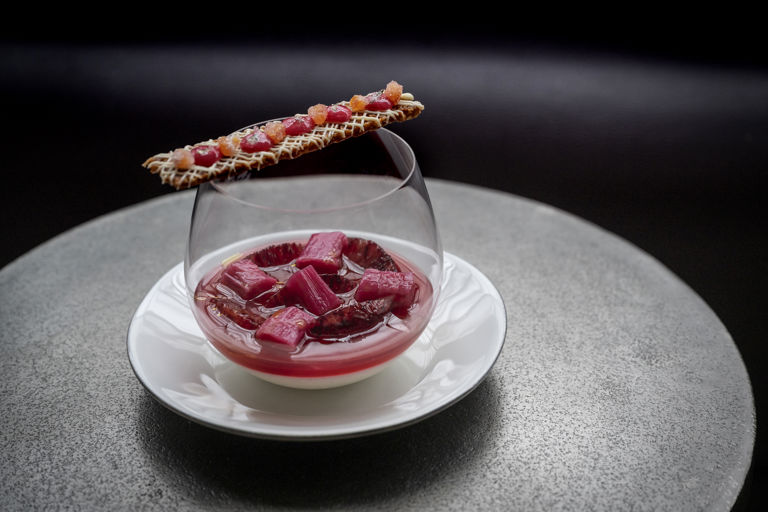Poached Yorkshire rhubarb with vanilla crème fraîche, blood orange, white chocolate and almond

- medium
- 4
- 3 hours
This stunning dessert is the perfect combination of blood orange and forced rhubarb – two highly seasonal ingredients that offer a colourful punch of sweetness towards the end of winter and beginning of spring. Served with a snappy almond biscuit on top, it requires some forward planning to pull off; take your time in the kitchen, however, and you'll be rewarded with a knockout dish to end any meal.
Note that some of the more time-consuming elements (like the candied orange and rhubarb purée) are only needed to top the biscuit, so to make this dish easier you could simply focus on what's in the glass and serve with shop-bought biscuits or your own simpler biscuit recipe (it's nice to have something crunchy to enjoy with it, however).
Ingredients
Metric
Imperial
Rhubarb
- 200g of forced rhubarb, washed and woody stems removed
- 1 blood orange, zested
- 60g of caster sugar
Vanilla crème fraîche
- 170g of crème fraîche
- 170g of whole milk
- 40g of caster sugar
- 1 vanilla pod
- 1 bronze gelatine leaf
Blood orange jelly
- 100ml of blood orange juice, squeezed from approx. 2 blood oranges
- 2 tsp caster sugar
- 1/2 bronze gelatine leaf
Rhubarb purée (if preparing the biscuits)
- 150g of forced rhubarb, washed
- 30g of caster sugar
Candied orange (if preparing the biscuits)
- 2 slices of blood oranges, 3mm thick and cut from the centre of the orange to form discs
- 250g of caster sugar
- 180ml of water
biscuit (optional)
- 45g of unsalted butter
- 55g of icing sugar
- 55g of nibbed almonds, or chopped blanched almonds
- 1/2 orange, zested
- 1 tbsp of orange juice
- 1 tbsp of plain flour
- 20g of white chocolate, for decorating
To serve
- 2 tsp lemon oil, ideally Sicilian lemon cold-pressed rapeseed oil
- 2 blood oranges
Equipment
- Squeezy bottle
- Piping bag with a thin nozzle
Method
- 2 slices of blood oranges, 3mm thick and cut from the centre of the orange to form discs
- 180g of caster sugar
- 180ml of water
- 1 bronze gelatine leaf
- 170g of whole milk
- 1 vanilla pod
- 40g of caster sugar
- 170g of crème fraîche
- 150g of forced rhubarb, washed
- 30g of caster sugar
- 200g of forced rhubarb, washed and woody stems removed
- 60g of caster sugar
- 1 blood orange, zested
- 70g of caster sugar
- 1/2 bronze gelatine leaf
- 100ml of blood orange juice, squeezed from approx. 2 blood oranges
- 2 tsp caster sugar
- 45g of unsalted butter
- 55g of icing sugar
- 55g of nibbed almonds, or chopped blanched almonds
- 1/2 orange, zested
- 1 tbsp of orange juice
- 1 tbsp of plain flour
- 20g of white chocolate, for decorating
- 2 tsp lemon oil, ideally Sicilian lemon cold-pressed rapeseed oil
Get in touch
Please sign in or register to send a comment to Great British Chefs.

